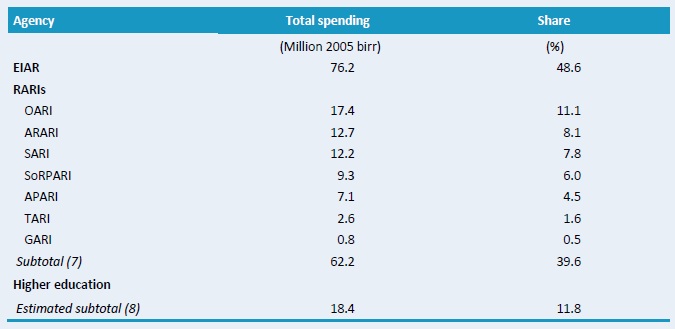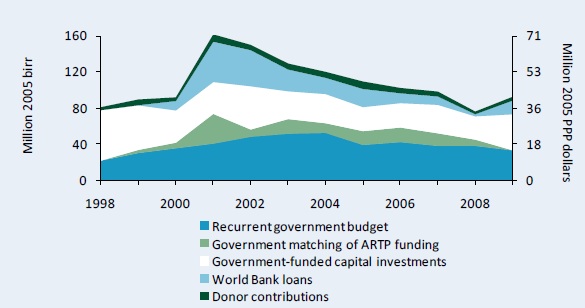The ASTI Data in Focus series provides additional background data in support of the 2010 Country Note on Ethiopia (asti.cgiar.org/pdf/Ethiopia-Note.pdf) prepared by the Agricultural Science and Technology Indicators (ASTI) initiative and the Ethiopian Institute of Agricultural Research (EIAR). Based on data collected by ASTI and EIAR, these two outputs review major investment and capacity trends in Ethiopian public agricultural research and development (R&D) since 1971, providing important updates on agricultural R&D trends prepared by ASTI and EIAR in 2003–04.
B. Financial Resources
This section provides detailed quantitative information on expenditures in Ethiopian public agricultural R&D for the period 1991–2008. Complementary sections present detailed data on long-term trends (Section A), human resources (Section C), and research allocation (Section D). Other supporting information provides macroeconomic trends, a list of agencies included in the study, data sources and estimation procedures, and ASTI's methodology.
Table B1–Total spending across various agencies, 2008
In 2008, the Ethiopian Institute of Agricultural Research (EIAR) accounted for the largest share of expenditures of any single agency, at 76.2 billion 2005 birr. The Oromia Agricultural Research Institute (OARI), which ranked second, reported expenditures of 17.4 billion 2005 birr. The Regional Agricultural Research Institutes (RARIs) accounted for a combined total of 40 percent agricultural R&D expenditures in 2008.

Source: Calculated by authors from ASTI–EIAR 2009–10 and various financial files from EIAR.
Notes: Figures in parentheses indicate the number of agencies in each category. Expenditures for the eight higher education agencies were estimated. For more information on coverage and estimation procedures, see the Ethiopia's country page on ASTI's website at asti.cgiar.org/ethiopia/datacoverage. For full agency names see asti.cgiar.org/ethiopia/agencies.
Figure B1–Spending levels of EIAR by funding source, 1998–2009
EIAR's recurrent government budget spending doubled between 1998 and 2004, reflecting increased staffing levels at EIAR. Subsequently, both recurrent spending and researcher numbers fell. Government-funded capital investments were relatively high during this period. Overall, spending levels fluctuated due to two World Bank loans–the Agricultural Research and Training Project (ARTP) and the Rural Capacity Building Project (RCBP)–which provided substantial levels of funding for the rehabilitation of research infrastructure and equipment, as well as the development of human resource capacity. Donor contributions were fairly constant, but only accounted for 4 percent of total spending in 2009.

Source: Calculated by authors from Beintema and Solomon 2003, ASTI 2009–10, and various financial files from EIAR.
Notes: Dates correspond to a July–June fiscal year. EIAR spending data for 1998–2005 were partly based on budget data rather than actual expenses.
Copyright (C) 2011 International Food Policy Research Institute and Ethiopian Institute of Agricultural Research. Sections of this Data in Focus issue may be reproduced without the express permission of, but with acknowledgment to, IFPRI and EIAR. The Data in Focus series is an output of the ASTI initiative and has not been peer reviewed. Any opinions stated herein are those of ASTI and do not necessarily reflect the policies and opinions of IFPRI or EIAR.
